technical data SMART FORTWO COUPE 2012 Owners Manual
[x] Cancel search | Manufacturer: SMART, Model Year: 2012, Model line: FORTWO COUPE, Model: SMART FORTWO COUPE 2012Pages: 228, PDF Size: 12.76 MB
Page 5 of 228
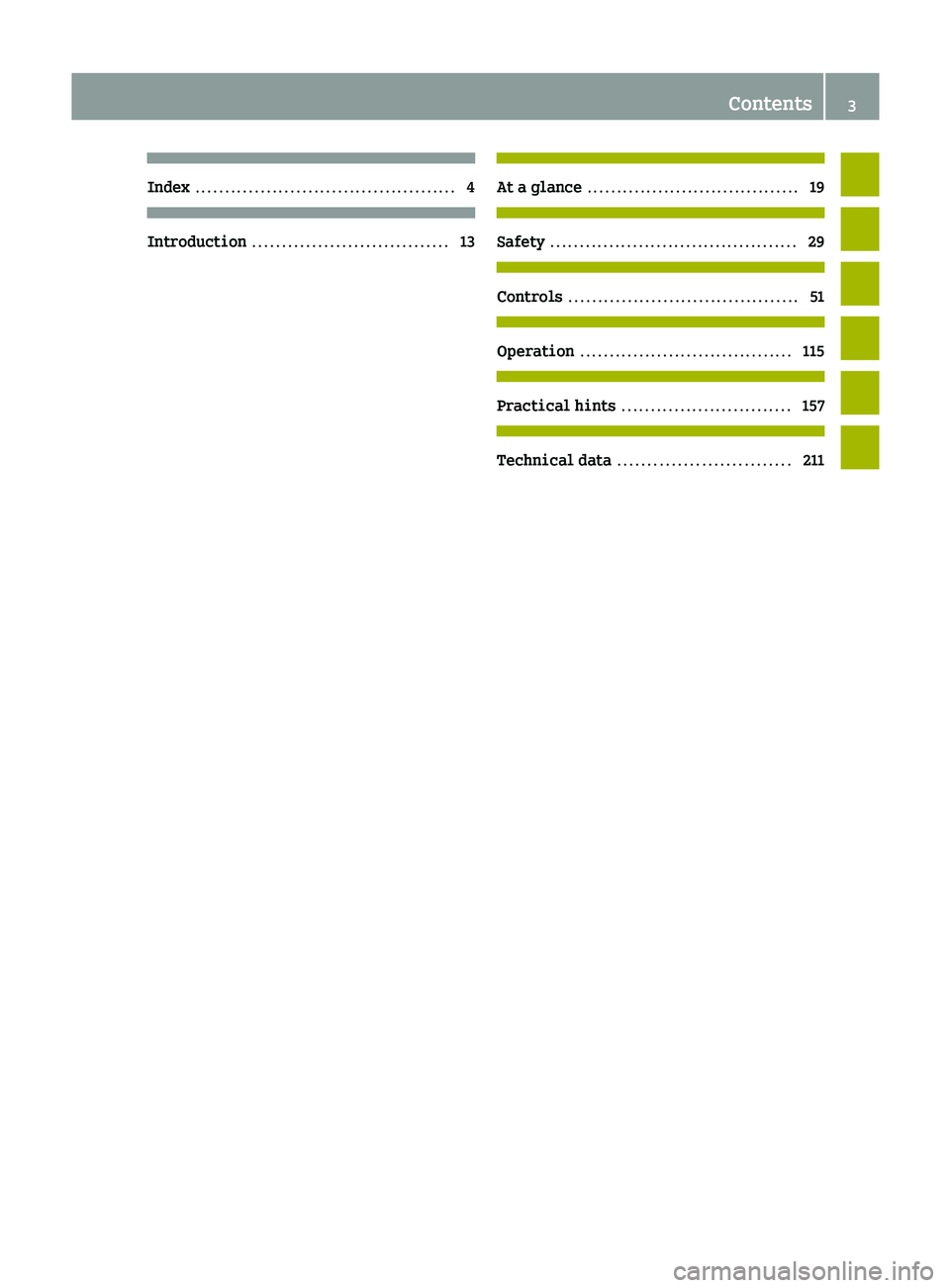
Index ............................................
4Introduction
................................. 13 At a glance ....................................
19 Safety ..........................................
29 Controls .......................................
51 Operation
.................................... 115 Practical hints
............................. 157 Technical data
............................. 211 Contents
3
Page 12 of 228
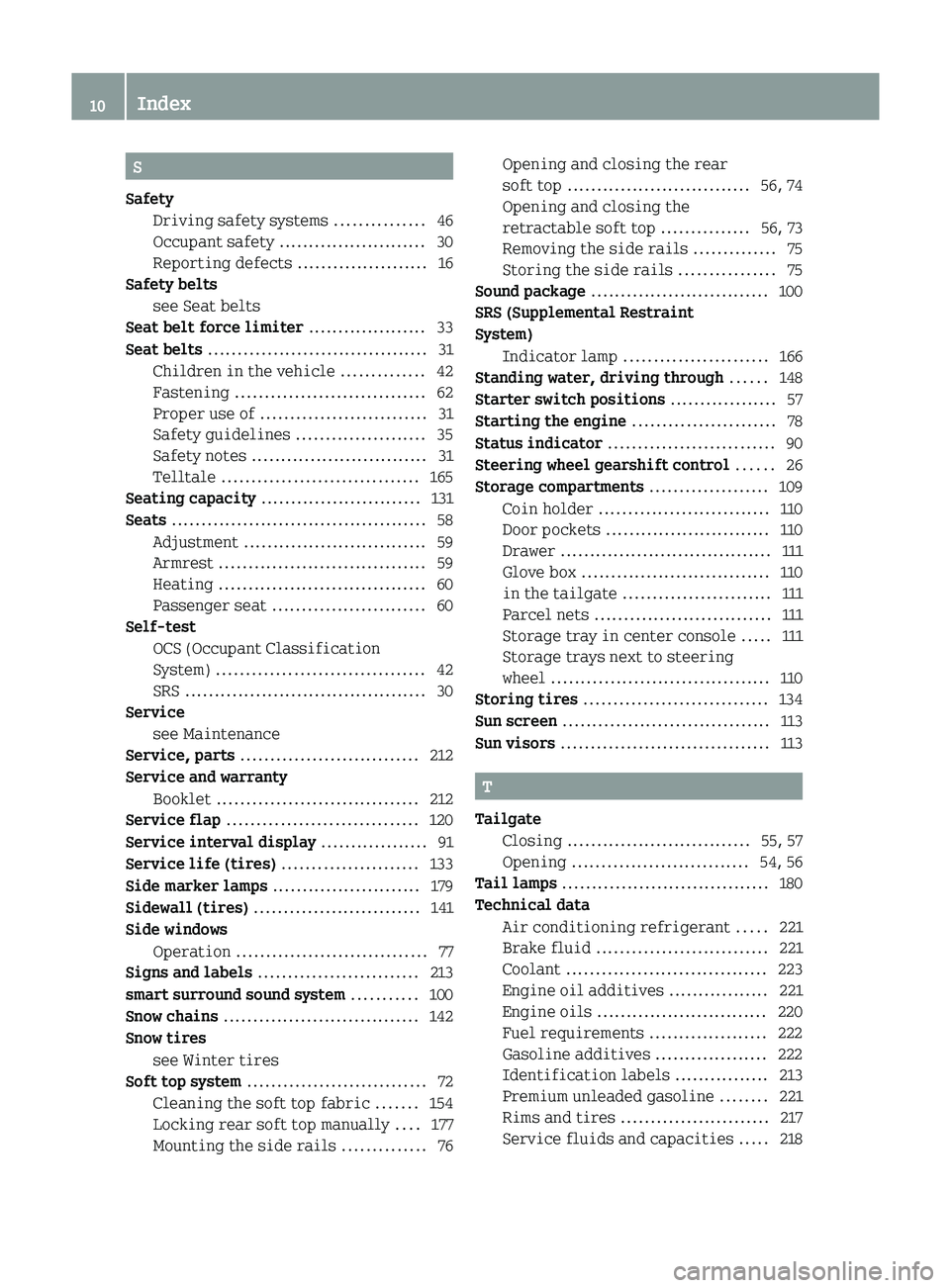
S
Safety Driving safety systems
...............46
Occupant safety ......................... 30
Reporting defects ...................... 16
Safety belts
see Seat belts
Seat belt force limiter .................... 33
Seat belts ..................................... 31
Children in the vehicle ..............42
Fastening ................................ 62
Proper use of ............................ 31
Safety guidelines ...................... 35
Safety notes .............................. 31
Telltale ................................. 165
Seating capacity ........................... 131
Seats ........................................... 58
Adjustment ............................... 59
Armrest ................................... 59
Heating ................................... 60
Passenger seat .......................... 60
Self-test
OCS (Occupant Classification
System) ................................... 42
SRS ......................................... 30
Service
see Maintenance
Service, parts .............................. 212
Service and warranty Booklet .................................. 212
Service flap ................................ 120
Service interval display ..................91
Service life (tires) ....................... 133
Side marker lamps ......................... 179
Sidewall (tires) ............................ 141
Side windows Operation ................................ 77
Signs and labels ........................... 213
smart surround sound system ...........100
Snow chains ................................. 142
Snow tires see Winter tires
Soft top system .............................. 72
Cleaning the soft top fabric ....... 154
Locking rear soft top manually ....177
Mounting the side rails .............. 76Opening and closing the rear
soft top
............................... 56, 74
Opening and closing the
retractable soft top
...............56, 73
Removing the side rails .............. 75
Storing the side rails ................75
Sound package .............................. 100
SRS (Supplemental Restraint
System)
Indicator lamp ........................ 166
Standing water, driving through ......148
Starter switch positions ..................57
Starting the engine ........................ 78
Status indicator ............................ 90
Steering wheel gearshift control ......26
Storage compartments ....................109
Coin holder ............................. 110
Door pockets ............................ 110
Drawer .................................... 111
Glove box ................................ 110
in the tailgate ......................... 111
Parcel nets .............................. 111
Storage tray in center console ..... 111
Storage trays next to steering
wheel ..................................... 110
Storing tires ............................... 134
Sun screen ................................... 113
Sun visors ................................... 113 T
Tailgate Closing ............................... 55, 57
Opening .............................. 54, 56
Tail lamps ................................... 180
Technical data Air conditioning refrigerant ..... 221
Brake fluid ............................. 221
Coolant .................................. 223
Engine oil additives .................
221
Engine oils ............................. 220
Fuel requirements .................... 222
Gasoline additives ................... 222
Identification labels ................ 213
Premium unleaded gasoline ........ 221
Rims and tires ......................... 217
Service fluids and capacities .....21810
Index
Page 13 of 228
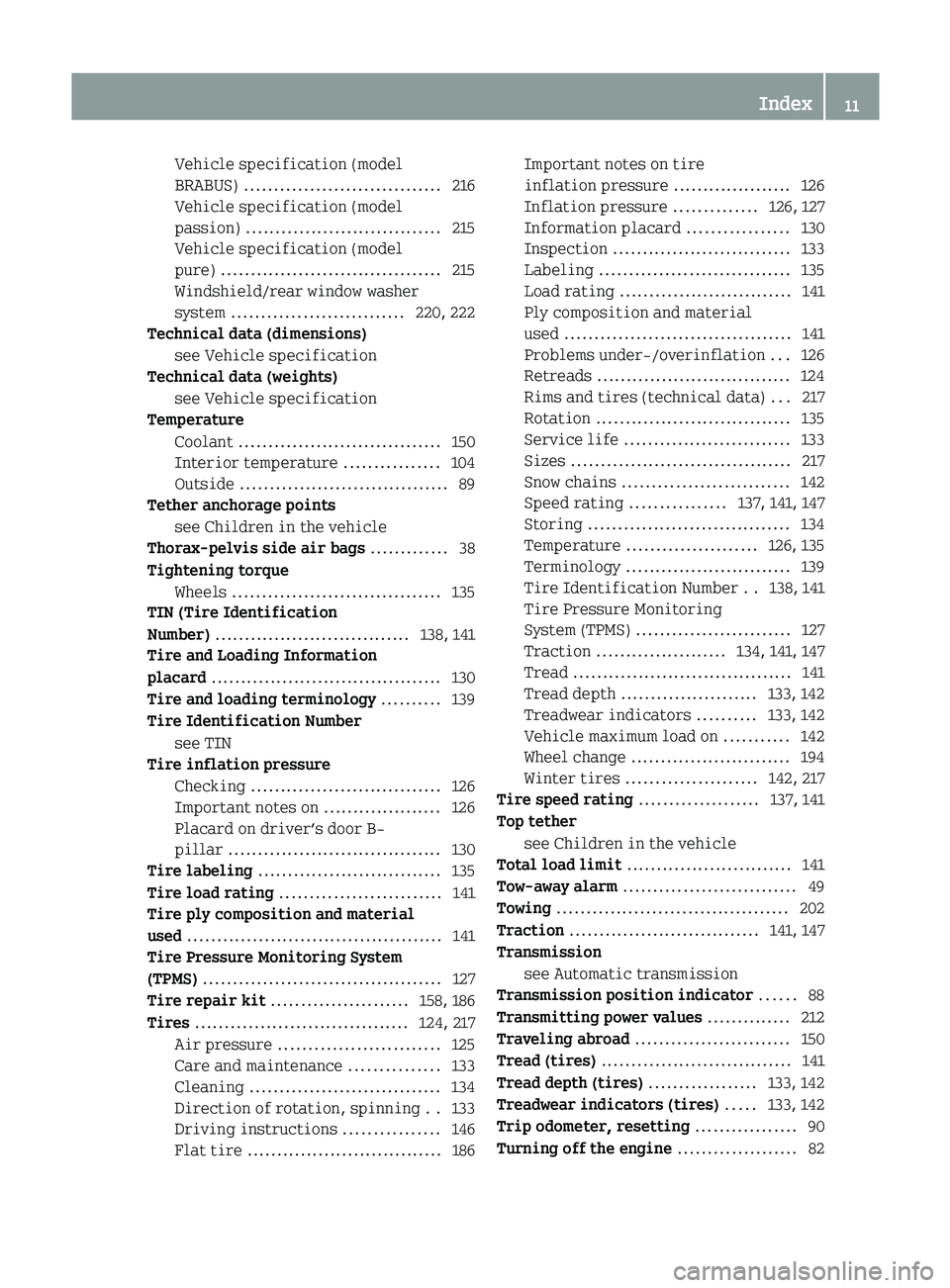
Vehicle specification (model
BRABUS) .................................
216
Vehicle specification (model
passion) ................................. 215
Vehicle specification (model
pure) ..................................... 215
Windshield/rear window washer
system ............................. 220, 222
Technical data (dimensions)
see Vehicle specification
Technical data (weights)
see Vehicle specification
Temperature
Coolant .................................. 150
Interior temperature ................ 104
Outside ................................... 89
Tether anchorage points
see Children in the vehicle
Thorax-pelvis side air bags .............38
Tightening torque Wheels ................................... 135
TIN (Tire Identification
Number) ................................. 138, 141
Tire and Loading Information
placard ....................................... 130
Tire and loading terminology ..........139
Tire Identification Number see TIN
Tire inflation pressure
Checking ................................ 126
Important notes on .................... 126
Placard on driver’s door B-
pillar .................................... 130
Tire labeling ............................... 135
Tire load rating ........................... 141
Tire ply composition and material
used ........................................... 141
Tire Pressure Monitoring System
(TPMS) ........................................ 127
Tire repair kit ....................... 158, 186
Tires .................................... 124, 217
Air pressure ........................... 125
Care and maintenance ............... 133
Cleaning ................................ 134
Direction of rotation, spinning .. 133
Driving instructions ................146
Flat tire ................................. 186Important notes on tire
inflation pressure ....................
126
Inflation pressure ..............126, 127
Information placard .................130
Inspection .............................. 133
Labeling ................................ 135
Load rating ............................. 141
Ply composition and material
used ...................................... 141
Problems under-/overinflation ... 126
Retreads ................................. 124
Rims and tires (technical data) ... 217
Rotation ................................. 135
Service life ............................ 133
Sizes ..................................... 217
Snow chains ............................ 142
Speed rating ................ 137, 141, 147
Storing .................................. 134
Temperature ...................... 126, 135
Terminology ............................ 139
Tire Identification Number ..138, 141
Tire Pressure Monitoring
System (TPMS) .......................... 127
Traction ...................... 134, 141, 147
Tread ..................................... 141
Tread depth ....................... 133, 142
Treadwear indicators ..........133, 142
Vehicle maximum load on ...........142
Wheel change ........................... 194
Winter tires ...................... 142, 217
Tire speed rating .................... 137, 141
Top tether see Children in the vehicle
Total load limit ............................ 141
Tow-away alarm ............................. 49
Towing ....................................... 202
Traction ................................ 141, 147
Transmission see Automatic transmission
Transmission position indicator ......88
Transmitting power values ..............212
Traveling abroad .......................... 150
Tread (tires) ................................ 141
Tread depth (tires) .................. 133, 142
Treadwear indicators (tires) .....133, 142
Trip odometer, resetting .................90
Turning off the engine .................... 82 Index
11
Page 18 of 228
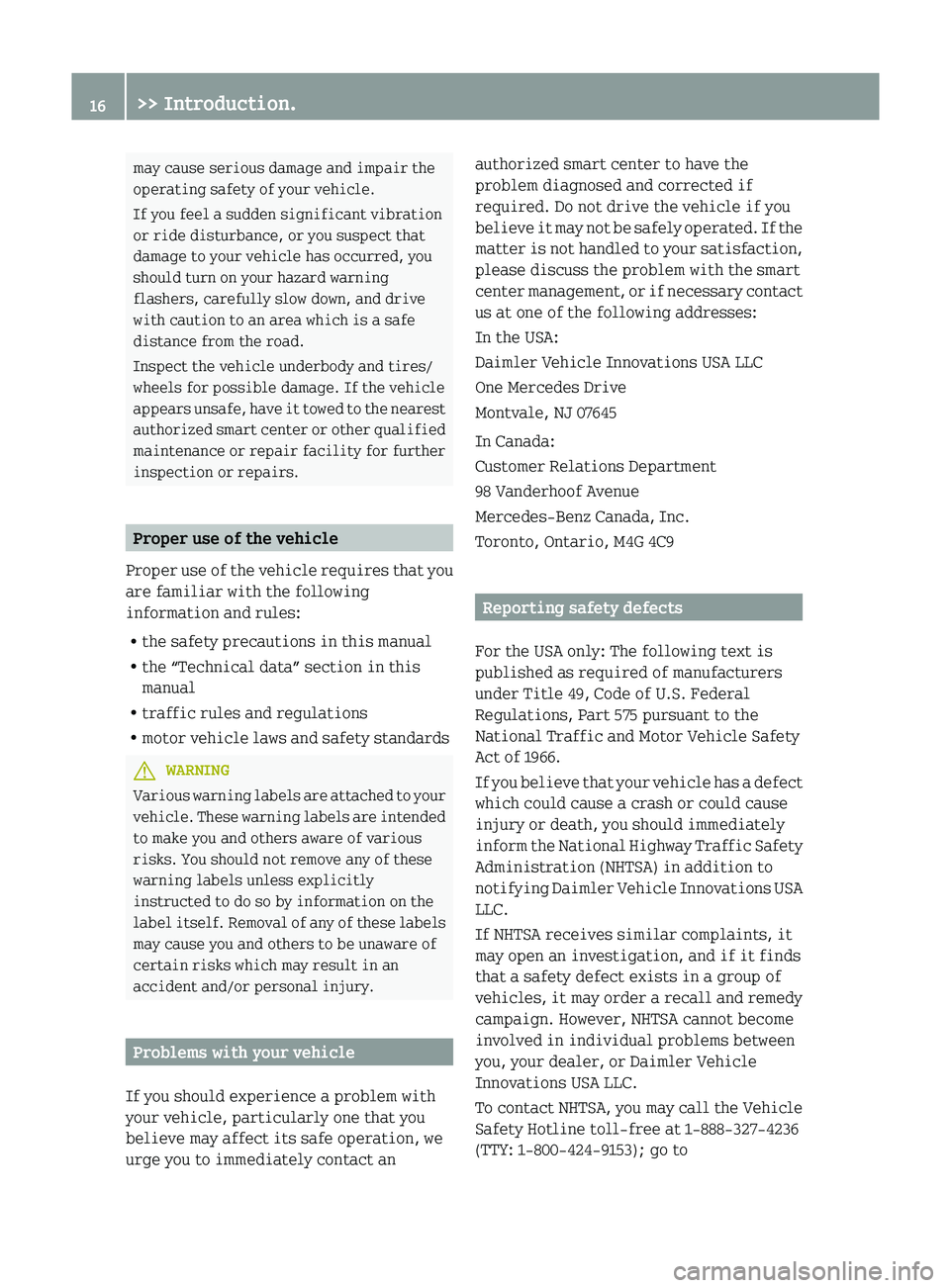
may cause serious damage and impair the
operating safety of your vehicle.
If you feel a sudden significant vibration
or ride disturbance, or you suspect that
damage to your vehicle has occurred, you
should turn on your hazard warning
flashers, carefully slow down, and drive
with caution to an area which is a safe
distance from the road.
Inspect the vehicle underbody and tires/
wheels for possible damage. If the vehicle
appears
unsafe, have it towed to the nearest
authorized smart center or other qualified
maintenance or repair facility for further
inspection or repairs. Proper use of the vehicle
Proper
use of the vehicle requires that you
are familiar with the following
information and rules:
R the safety precautions in this manual
R the “Technical data” section in this
manual
R traffic rules and regulations
R motor vehicle laws and safety standards G
WARNING
Various warning labels are attached to your
vehicle.
These warning labels are intended
to make you and others aware of various
risks. You should not remove any of these
warning labels unless explicitly
instructed to do so by information on the
label itself. Removal of any of these labels
may cause you and others to be unaware of
certain risks which may result in an
accident and/or personal injury. Problems with your vehicle
If you should experience a problem with
your vehicle, particularly one that you
believe may affect its safe operation, we
urge you to immediately contact an authorized smart center to have the
problem diagnosed and corrected if
required. Do not drive the vehicle if you
believe
it may not be safely operated. If the
matter is not handled to your satisfaction,
please discuss the problem with the smart
center management, or if necessary contact
us at one of the following addresses:
In the USA:
Daimler Vehicle Innovations USA LLC
One Mercedes Drive
Montvale, NJ 07645
In Canada:
Customer Relations Department
98 Vanderhoof Avenue
Mercedes-Benz Canada, Inc.
Toronto, Ontario, M4G 4C9 Reporting safety defects
For the USA only: The following text is
published as required of manufacturers
under Title 49, Code of U.S. Federal
Regulations, Part 575 pursuant to the
National Traffic and Motor Vehicle Safety
Act of 1966.
If
you believe that your vehicle has a defect
which could cause a crash or could cause
injury or death, you should immediately
inform the National Highway Traffic Safety
Administration (NHTSA) in addition to
notifying Daimler Vehicle Innovations USA
LLC.
If NHTSA receives similar complaints, it
may open an investigation, and if it finds
that a safety defect exists in a group of
vehicles, it may order a recall and remedy
campaign. However, NHTSA cannot become
involved in individual problems between
you, your dealer, or Daimler Vehicle
Innovations USA LLC.
To contact NHTSA, you may call the Vehicle
Safety Hotline toll-free at 1-888-327-4236
(TTY: 1-800-424-9153); go to 16
>> Introduction.
Page 134 of 228

Examples for steps 1 to 3
Example 1 Example 2
Step 1 Combined weight limit of
occupants
and cargo from Tire and
Loading Information placard 540 lbs 540 lbs
Step 2 Number of occupants (driver and
passenger)
2 1
Occupants weight
Occupant 1: 150 lbs
Occupant 2: 180 lbs Occupant 1: 150 lbs
Combined weight of all occupants
330 lbs 150 lbs
Step 3 Available cargo weight (total load
limit from Tire and Loading
Information placard minus
combined weight of all occupants)
540 lbs - 330 lbs =
210 lbs 540 lbs - 150 lbs =
390 lbs
Certification label
Even after careful determination of the
combined
weight of all occupants and cargo
as to not exceed the permissible load
limit, you must make sure your vehicle
never exceeds the Gross Vehicle Weight
Rating (GVWR) and the Gross Axle Weight
Rating (GAWR) for either the front or rear
axle. You can obtain the GVWR and GAWR
from the certification label. The
certification label can be found on the
driver’s door B‑pillar, see “Technical
data” (Y page 214).
Gross Vehicle Weight Rating (GVWR) means:
The total weight of the vehicle, all
occupants, and all cargo must never exceed
the GVWR.
Gross Axle Weight Rating (GAWR) means:
The total allowable weight that can be
carried by a single axle (front or rear).
To assure that your vehicle does not exceed
the maximum permissible weight limits
(GVWR and GAWR for front and rear axle),
have the loaded vehicle (including driver,
passenger, and all cargo) weighed on a
suitable commercial scale. Maximum tire load
G
WARNING
Do not overload the tires by exceeding the
specified load limit as indicated on the
Tire and Loading Information placard on
the
driver’s door B‑pillar. Overloading the
tires can overheat them, possibly causing
a blowout. Overloading the tires can also
result in handling or steering problems, or
brake failure. i
For illustration purposes only. Actual
data
on tires are specific to each vehicle
and may vary from data shown in above
illustration.
The maximum tire load : is the maximum
weight the tires are designed to support. 132
Tires and wheels
>> Operation.
Page 144 of 228
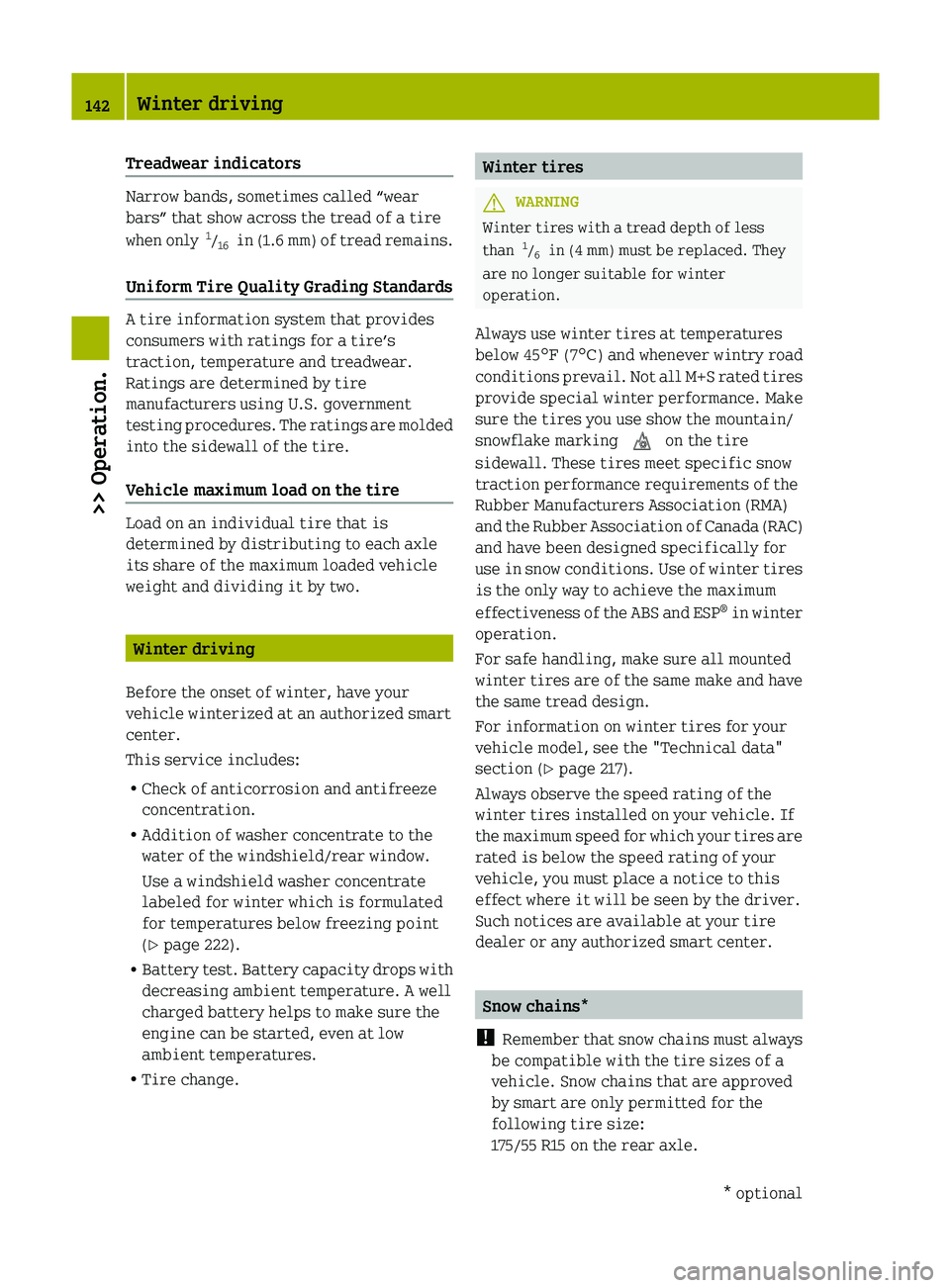
Treadwear indicators
Narrow bands, sometimes called “wear
bars” that show across the tread of a tire
when
only 1
/ 16 in (1.6 mm) of tread remains.
Uniform Tire Quality Grading Standards A tire information system that provides
consumers with ratings for a tire’s
traction, temperature and treadwear.
Ratings are determined by tire
manufacturers using U.S. government
testing
procedures. The ratings are molded
into the sidewall of the tire.
Vehicle maximum load on the tire Load on an individual tire that is
determined by distributing to each axle
its share of the maximum loaded vehicle
weight and dividing it by two.
Winter driving
Before the onset of winter, have your
vehicle winterized at an authorized smart
center.
This service includes:
R Check of anticorrosion and antifreeze
concentration.
R Addition of washer concentrate to the
water of the windshield/rear window.
Use a windshield washer concentrate
labeled for winter which is formulated
for temperatures below freezing point
(Y page 222).
R Battery
test. Battery capacity drops with
decreasing ambient temperature. A well
charged battery helps to make sure the
engine can be started, even at low
ambient temperatures.
R Tire change. Winter tires
G
WARNING
Winter tires with a tread depth of less
than 1
/ 6 in (4 mm) must be replaced. They
are no longer suitable for winter
operation.
Always use winter tires at temperatures
below 45 ¦ (7¥) and whenever wintry road
conditions
prevail. Not all M+S rated tires
provide special winter performance. Make
sure the tires you use show the mountain/
snowflake marking i on the tire
sidewall. These tires meet specific snow
traction performance requirements of the
Rubber Manufacturers Association (RMA)
and the Rubber Association of Canada (RAC)
and have been designed specifically for
use in snow conditions. Use of winter tires
is the only way to achieve the maximum
effectiveness of the ABS and ESP ®
in winter
operation.
For safe handling, make sure all mounted
winter tires are of the same make and have
the same tread design.
For information on winter tires for your
vehicle model, see the "Technical data"
section (Y page 217).
Always observe the speed rating of the
winter tires installed on your vehicle. If
the maximum speed for which your tires are
rated is below the speed rating of your
vehicle, you must place a notice to this
effect where it will be seen by the driver.
Such notices are available at your tire
dealer or any authorized smart center. Snow chains*
! Remember
that snow chains must always
be compatible with the tire sizes of a
vehicle. Snow chains that are approved
by smart are only permitted for the
following tire size:
175/55 R15 on the rear axle. 142
Winter driving
>> Operation.
* optional
Page 149 of 228

Depending upon the weather and/or road
surface (conditions), the tire traction
varies widely.
Specified
tire inflation pressures must be
maintained. This applies particularly if
the tires are subject to high loads (e.g.
high speeds, heavy loads, high ambient
temperatures). G
WARNING
Do not drive with a flat tire. A flat tire will
affect
your ability to steer or brake and may
cause you to lose control of the vehicle.
Continued driving with a flat tire or
driving at high speed with a flat tire will
cause excessive heat build-up and possibly
a fire.
For more information, see “Tires and
wheels” (Y page 124). Hydroplaning
Depending on the depth of the water layer
on the road, hydroplaning may occur
resulting in a loss of control, even at low
speeds and with new tires. Reduce vehicle
speed, avoid track grooves in the road and
apply
brakes cautiously when it is raining. Tire traction
The
safe speed on a wet, snow covered or icy
road is always lower than on a dry road.
You should pay particular attention to the
condition of the road whenever the outside
temperatures are close to the freezing
point. G
WARNING
If ice has formed on the road, tire traction
will be substantially reduced. Under such
weather
conditions, drive, steer and brake
with extreme caution.
smart recommends winter tires
(Y page 142) with a minimum tread depth of approximately
1
/ 6 in (4 mm) on all four
wheels for the winter season to ensure
normal
balanced handling characteristics.
On packed snow, they can reduce your
stopping distance compared to summer
tires.
Stopping distance, however, is still
considerably greater than when the road is
not covered with snow or ice. Exercise
appropriate caution.
! Avoid spinning of a drive wheel for an
extended period when driving off on
slippery road surfaces. Otherwise, the
drivetrain could be damaged, which is
not covered by the smart Limited
Warranty. Tire speed rating
Regardless of the tire speed rating, local
speed
limits should be obeyed. Use prudent
driving speeds appropriate to prevailing
conditions. G
WARNING
Even when permitted by law, never operate
a vehicle at speeds greater than the
maximum speed rating of the tires.
Exceeding the maximum speed for which
tires are rated can lead to sudden tire
failure,
causing loss of vehicle control and
possibly resulting in an accident and/or
personal injury and possible death, for you
and for others.
An electronic speed limiter prevents your
vehicle from exceeding a speed of 90 mph
(145 km/h).
The factory equipped tires on your vehicle
may have a tire speed rating above the
maximum speed permitted by the
electronic speed limiter.
Make sure your tires have the required tire
speed rating as specified for your vehicle
in the “Technical data section” Driving instructions
147
>> Operation. Z
Page 213 of 228
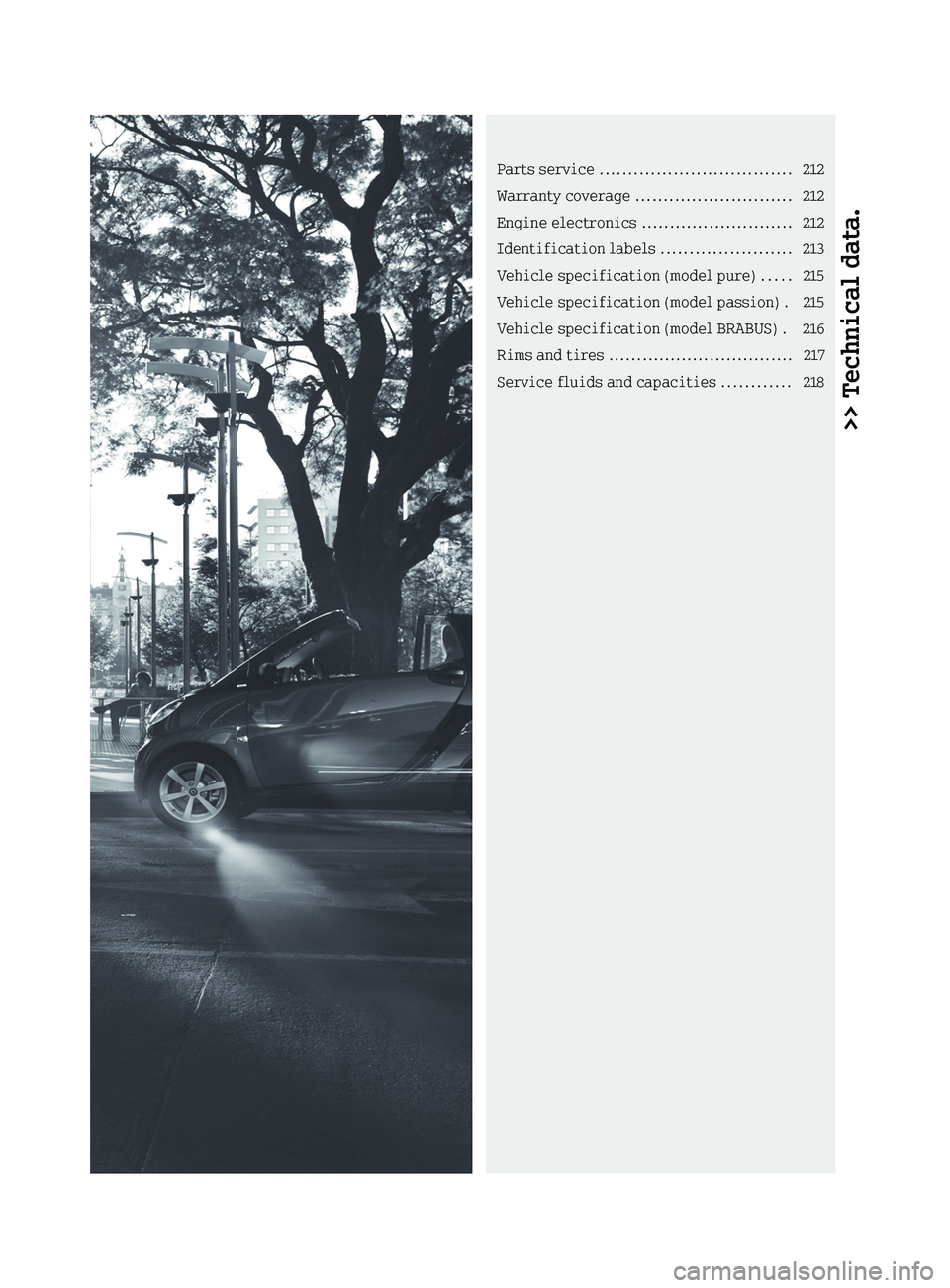
>> Technical data.Parts service
.................................. 212
Warranty coverage ............................ 212
Engine electronics ........................... 212
Identification labels ....................... 213
Vehicle specification (model pure) ..... 215
Vehicle specification (model passion) .
215
Vehicle specification (model BRABUS) . 216
Rims and tires ................................. 217
Service fluids and capacities ............218
Page 214 of 228

Parts service
The “Technical data” section provides the
necessary technical data for your vehicle.
Genuine smart Parts are subjected to
stringent quality inspections. Each part
has been specifically developed,
manufactured or selected for and adapted
to smart vehicles.
Therefore, Genuine smart Parts should be
installed.
! The
use of non-genuine smart parts and
accessories not authorized by smart
could damage the vehicle, which is not
covered by the smart Limited Warranty,
or could compromise the vehicle’s
durability or safety. Warranty coverage
Your vehicle is covered under the terms of
the warranties printed in the smart USA
Warranty
booklet (USA only) or the Warranty
booklet (Canada only).
Your authorized smart center will exchange
or repair any defective parts originally
installed on the vehicle in accordance with
the terms of the following warranties:
R smart USA Limited Warranty (USA only)
R New Vehicle Limited Warranty (Canada
only)
R Emission System Warranty
R Emission Performance Warranty
R Corrosion Warranty
R California, Connecticut, Maine,
Massachusetts, New York, Pennsylvania,
Rhode Island, and Vermont Emission
Control System Warranty
R smartmove Assistance (Canada only)
R State Warranty Enforcement Laws (Lemon
Laws, USA only)
Replacement parts and accessories are
covered by the smart Parts and Accessories warranties, copies of which are available
at any authorized smart center.
Loss of Warranty booklet
Should you lose your smart USA Warranty
booklet (USA only) or the Warranty booklet
(Canada only), have an authorized smart
center arrange for a replacement. It will
be mailed to you. Engine electronics
Work on engine electronics
G
WARNING
Always have maintenance work on engine
electronics
and components performed by a
qualified specialist, e.g. at a smart
center. In particular, work relevant to
safety or on safety related systems must be
carried out at a qualified specialist
workshop.
! Always have maintenance work on the
engine electronics and components, such
as control modules, sensors and
connecting cables, performed by a
qualified specialist who has the
necessary knowledge and tools to carry
out the work required, e.g. at a smart
center. Otherwise there is a danger that
vehicle components may wear more
rapidly, which may void the vehicle’s
warranty. Retrofitting electrical and electronic
devices
Electrical and electronic devices can
endanger vehicle operating safety.
! Damage
or consequential damage due to
retrofitting a device in the vehicle is
not covered by smart’s warranty.
If you install telephones or radio
transmitters in the vehicle you must have 212
Engine electronics
>> Technical data.
Page 215 of 228
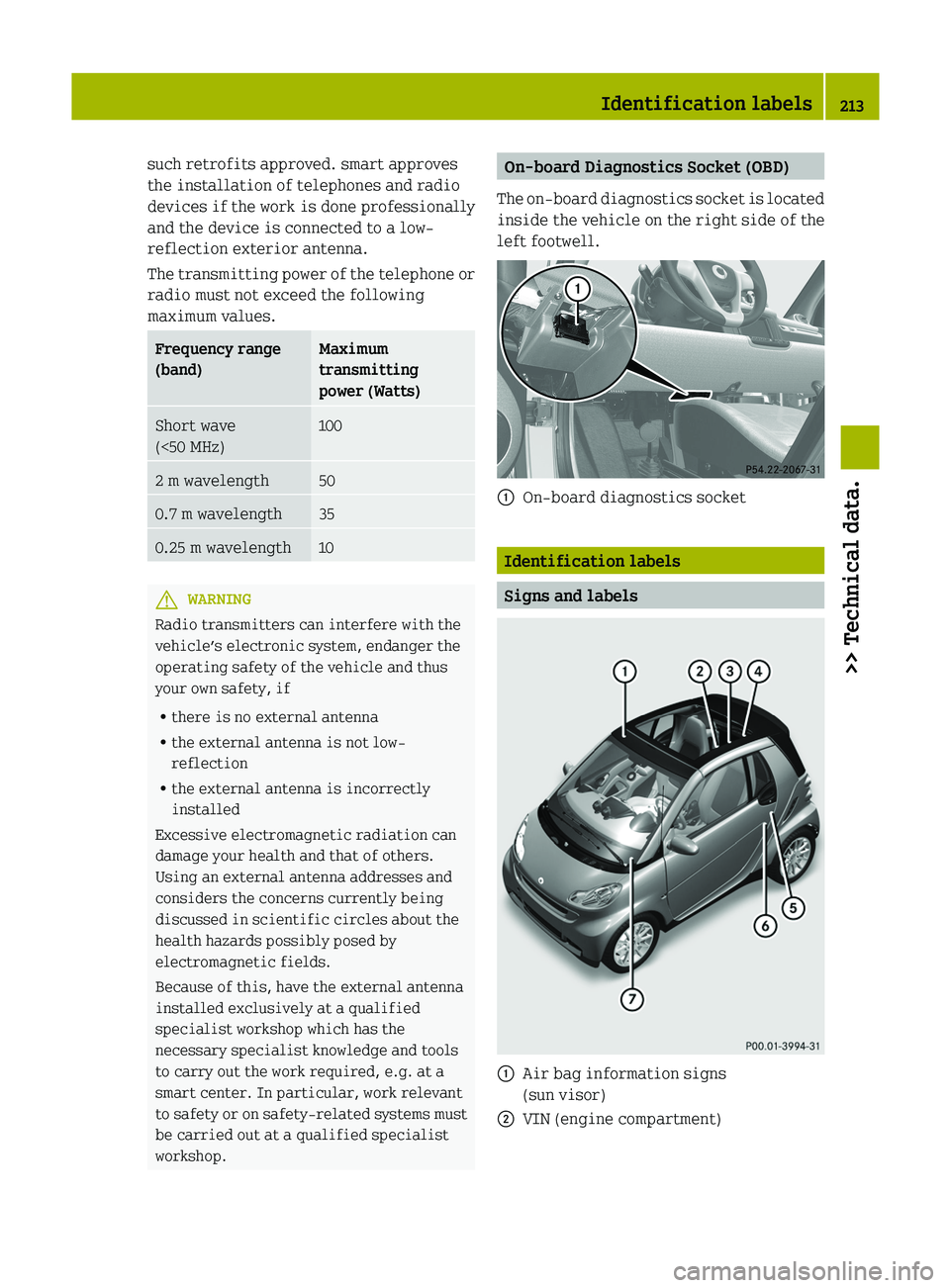
such retrofits approved. smart approves
the installation of telephones and radio
devices if the work is done professionally
and the device is connected to a low-
reflection exterior antenna.
The
transmitting power of the telephone or
radio must not exceed the following
maximum values. Frequency range
(band) Maximum
transmitting
power (Watts)
Short wave
(<50 MHz) 100
2 m wavelength 50
0.7 m wavelength 35
0.25 m wavelength 10
G
WARNING
Radio transmitters can interfere with the
vehicle’s electronic system, endanger the
operating safety of the vehicle and thus
your own safety, if
R there is no external antenna
R the external antenna is not low-
reflection
R the external antenna is incorrectly
installed
Excessive electromagnetic radiation can
damage your health and that of others.
Using an external antenna addresses and
considers the concerns currently being
discussed in scientific circles about the
health hazards possibly posed by
electromagnetic fields.
Because of this, have the external antenna
installed exclusively at a qualified
specialist workshop which has the
necessary specialist knowledge and tools
to carry out the work required, e.g. at a
smart center. In particular, work relevant
to
safety or on safety-related systems must
be carried out at a qualified specialist
workshop. On-board Diagnostics Socket (OBD)
The
on-board diagnostics socket is located
inside the vehicle on the right side of the
left footwell. :
On-board diagnostics socket Identification labels
Signs and labels
:
Air bag information signs
(sun visor)
; VIN (engine compartment) Identification labels
213
>> Technical data. Z